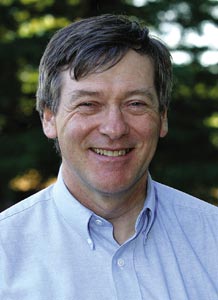A new institute at Stanford comes at just the right time, says Roger Blandford, future director of the Kavli Institute for Particle Astrophysics and Cosmology.

This is a great time to be an astrophysicist. Over the past 30 years, almost all of the roughly 70 octaves of the electromagnetic spectrum accessible for study have been opened up. Telescopes using new technologies have expanded our view of the cosmos far beyond what we see in the single octave available to traditional optical astronomy. The size, age and shape of the universe have been measured, and its black holes, neutron stars and extrasolar planets have been catalogued. We are on the threshold of using cosmic rays, neutrinos and gravitational waves to find new sources, and we are encountering a world of extremes. We must contemplate the diffuse intergalactic medium, as well as singularities with a nominal density more than 120 orders of magnitude larger. Similarly, we infer a difference in magnetic field strength between intergalactic space and the field in “magnetars” that ranges over 30 orders of magnitude.
Over the same period, the Standard Model of elementary particles has been largely completed. Almost all of the standard particles have been detected, and their properties fitted into a pattern. It is easy for physicists to take this for granted, but describing this framework surely ranks as one of the greatest scientific accomplishments of all time. Furthermore, the intellectual connection of this model to the equally rich fields of nuclear, atomic and condensed matter physics is well developed.
Now, in both astronomy and physics, the scientific focus is shifting from asking “what?” to trying to understand “why?” We want to understand why galaxies have the regular properties that are observed locally, just as we want to understand such things as the electron-proton mass ratio. In many cases, researchers from the two disciplines seem to be looking at the same problem from different perspectives. I expect that closer collaboration between the fields will lead to exciting advances in many areas where they intersect.
For example, astronomers have discovered that roughly seven-eighths of the matter in the universe is in a “dark” form whose properties they do not recognize. Meanwhile, physicists suspect that there is a whole new family of hitherto undetected supersymmetric partners to the standard particles. Both communities have concluded that they are probably discussing the same thing. In another instance, physicists are developing the theory of supersymmetric strings and its generalization as a tool for understanding the basis of the Standard Model, while astronomical measurements of the expansion of the universe have revealed the presence of “dark energy”, which strikes at the heart of string theory.
Recently, cosmic rays have been discovered with energies as large as 50 J – 10 million times more energetic than can be made at particle accelerators. Astronomers are divided as to whether these particles come from black holes and neutron stars, or if they derive from exotic matter left over from the Big Bang. If the former is correct, then the means by which the particles are boosted to these energies may be similar to some advanced concepts that have been developed for future particle accelerators. If the latter is correct, then nature is performing experiments for our benefit that we will never be able to carry out on Earth.
Finally, the technology and methodology of astronomical observation has changed from individual acquisition and scrutiny of mainly photographic images and spectra. The field now relies mainly on large teams of astrophysicists using modern, solid-state detectors which produce terabytes of digital data that must be processed, manipulated and archived – just as in particle physics experiments.
It is therefore clear that astronomers and physicists will be working together increasingly on everything from equations to electronics. However, this poses some interesting sociological challenges, because historically the two communities have worked in quite different ways. Physicists are used to designing active experiments, while astronomers are used to performing passive observations. The present time represents an extraordinary opportunity to build a facility capitalizing on the rich scientific heritages of astronomy and particle physics, and the complementary strengths that they bring to the emerging science at their interface.
Physicist Fred Kavli and the Kavli Foundation have pledged $7.5 million (€6.9 million) to establish an institute that will focus on recent developments in astrophysics, high-energy physics and cosmology. The new Kavli Institute for Particle Astrophysics and Cosmology will be located in a new building at the Stanford Linear Accelerator Center (SLAC), and will open its doors in 2005. I am honoured to have been chosen as the inaugural director. Steven Kahn of Columbia will join me as deputy director and assistant director of research at SLAC.
Initially, we intend to follow a balanced growth plan with theory, computational astrophysics and phenomenology on one hand, and experimental astrophysics and high-energy observing on the other. We will draw upon existing strengths at Stanford in theoretical (especially high-energy) physics and astrophysics, gamma-ray and X-ray astronomy, gravitational physics, microwave background instrumentation and underground physics.
Part of the excitement of the field is that it is impossible to predict where it will be in five years’ time and what its scientific focus will be. What is clear is that the time is right to build a world-class centre.








